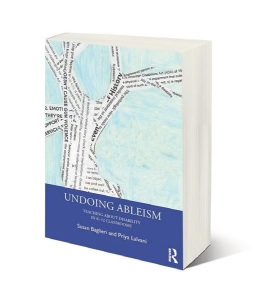CHILDREN UNDERSTAND AND THAT'S OK
The first step for educators is to understand that children notice – and even comprehend – disability, and they actually want to learn more about it.
The belief that children "don't notice" is not only incorrect, it can be potentially harmful, akin to striving to be "colorblind" when not noticing race. By not acknowledging others who may have disabilities around them, children may internalize that certain differences are valued while others should not be mentioned. They may learn to silence their natural curiosity about some differences they observe, creating an environment where educational opportunities are missed.
“We give children many messages about which differences are valued and which are not in society,” said Lalvani. “In the context of disability, we tell them not to look, not to stare, not to point out something that looks different. Children pick up on that; if they are not supposed to mention it, it cannot be a good thing. This is often a lesson learned through interaction with parents, but it is perpetuated when a child comes to school, and the same things are not allowed to be questioned and are not discussed.”
ABLEISM AT WORK
Ableism, Lalvani says, is at the root of this dynamic. If schools do anything regarding disability programming, it is most likely the standard "awareness days" in which community members wear a certain color, read about a famous person with a disability, or do activities that place children in the shoes of someone who is disabled (such as place children in a wheelchair).
All of these efforts, while well-intentioned, paint disability as something that needs to be overcome (the famous person is billed as a "hero" because they "overcame" their disability to achieve great things, for example), or reinforce negative stereotypes. Perhaps most importantly, though, they do not present teaching moments for children to learn about ableism and their own roles in it, and do not truly educate them about access, accommodations, or what they're seeing in their everyday lives.
"All of these initiatives are actually reinforcing ableism, not what they're trying to accomplish," said Lalvani. "If they want children to truly understand what it is like to have a disability, school districts and teachers must entirely rethink the experiences they are providing."

Title: Undoing Ableism: Teaching About Disability in K-12 Classrooms
Authors: Susan Baglieri and Priya Lalvani
Publisher: Routledge
Publication Date: September 2019
Paperback: 214 pages
ISBN-13: 978-1138545595
Available at: amazon.com and barnesandnoble.com
WHAT CAN BE DONE
Educators can begin to reverse this dynamic by inviting children, with and without disabilities, to learn about disability, disability rights, and disability pride and culture by providing them with the language and tools necessary to recognize all forms of oppression.
When beginning to design lessons surrounding disability, educators should ask themselves a series of questions.
First, if using a particular piece of educational content, determine from whose perspective the experience is being presented. Teachers, Lalvani says, should select materials that emphasize positive or neutral depictions of people with disabilities, particularly those written by such individuals to provide a more authentic educational experience.
Second, what dominant narratives or assumptions about disability are pre
sented? Are there any counternarratives present? There is a lot of content available to teach disability, but teachers must be critical consumers, and spot content that is ableist in and of itself before administering it.
But that isn't enough. Lalvani urges teachers to seek out content that introduces ableism through counternarratives, such as the reclaiming of language and history of disability, questioning what is "normal", highlighting social and attitudinal barriers, or drawing attention to lack of access and acceptance.
Also, children should be given the tools necessary to spot problematic content and conversations, and examine them to learn why it is an issue. Popular culture is rife with negative stereotypes and ableist narratives, similar to the experiences created for children when they are taught about disability. Children should be given the space to analyze the content they see in TV, movies and books, and discuss why it may further perpetuate negative stereotypes.
Perhaps most importantly, these changes should be made across the entire curriculum, across all subjects, throughout the year. If this framework is infused in all areas of the educational experience, Lalvani says that children will be infinitely more informed - making conversations about disability easier for parents, as well.
"By implementing a framework like this, teachers are empowered to create change in the classroom. But that change will be felt at home, as well, because both children and their parents will be able to have better conversations about disability not rooted in ableism. Parents can take these recommendations and begin to shift the conversations they're having with their children about disability, whether or not they are disabled. By doing so, they're laying the groundwork to disrupt ableism – and, if it is then supported in schools, we can begin to change the way disabled people are viewed in our society." •
ABOUT THE AUTHOR:
Andrew Mees is the Media Relations Director at Montclair State University.